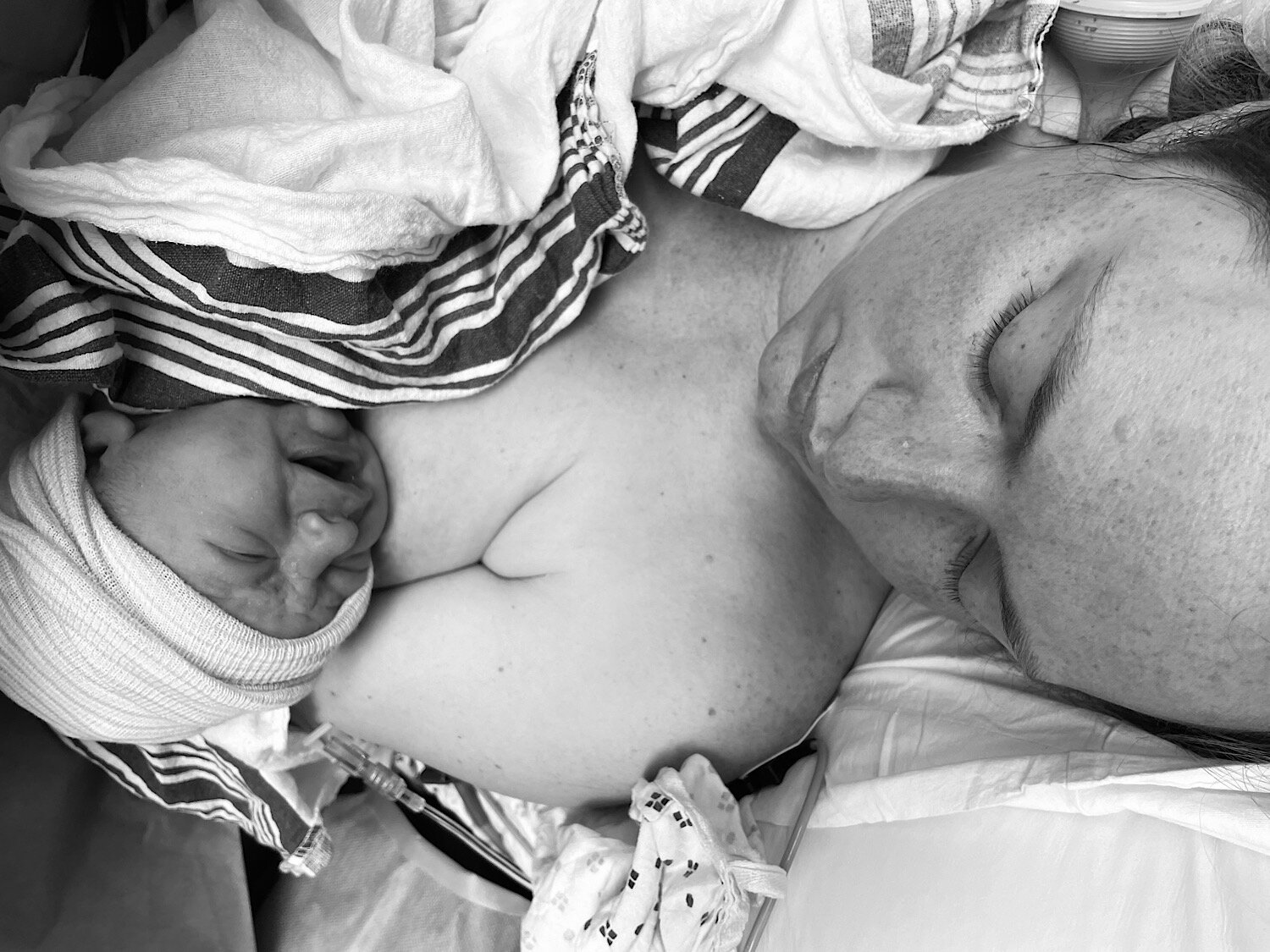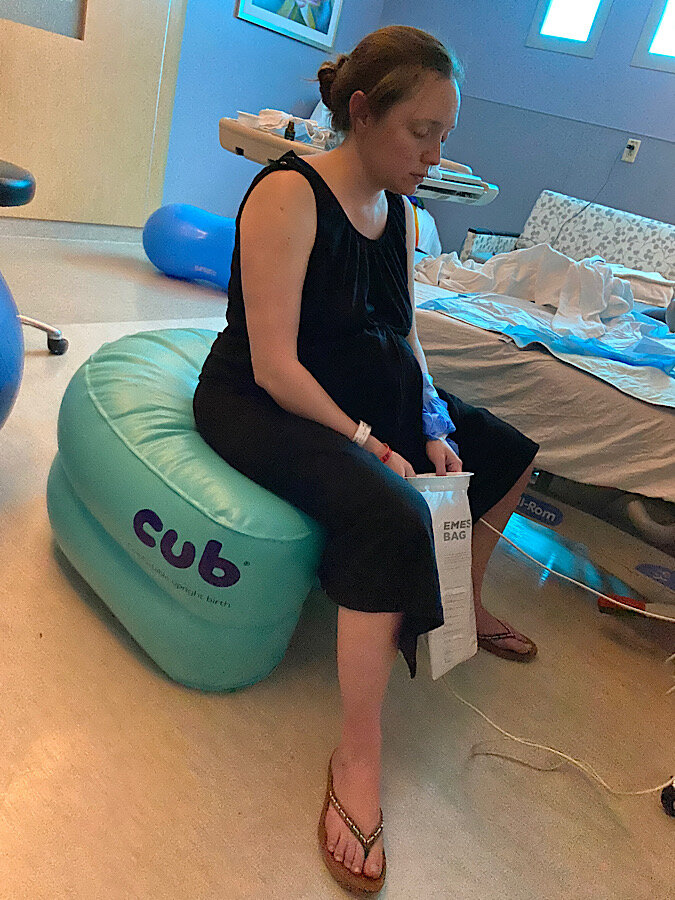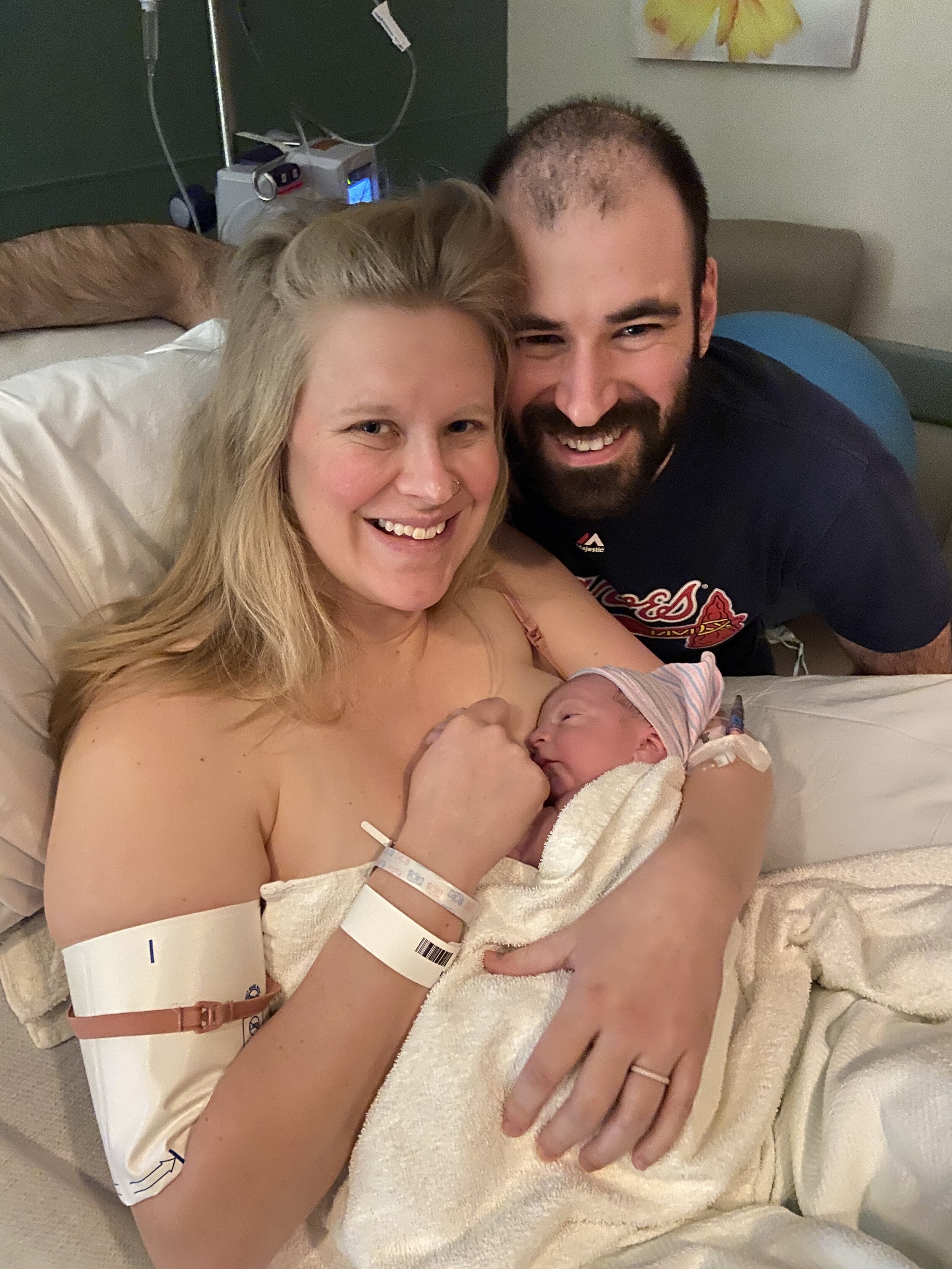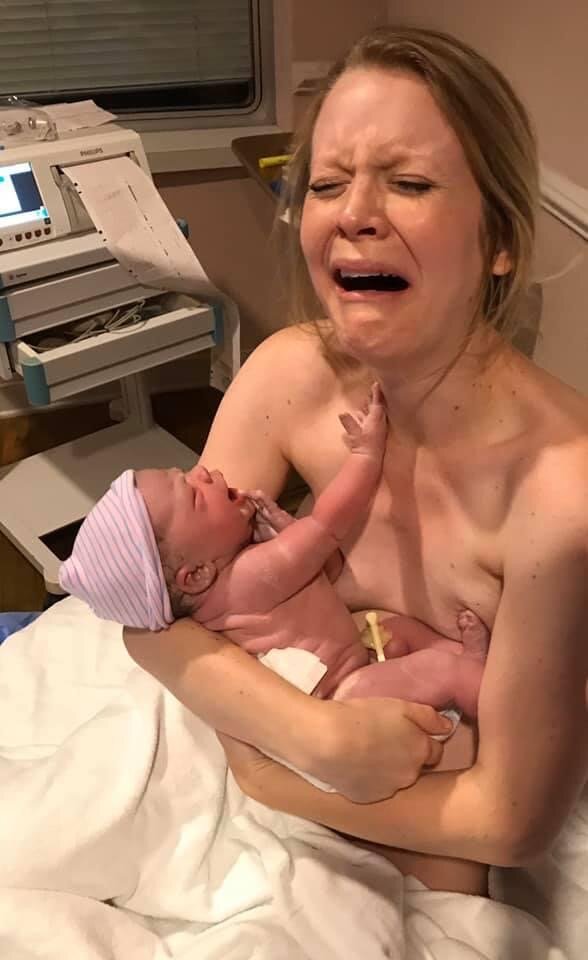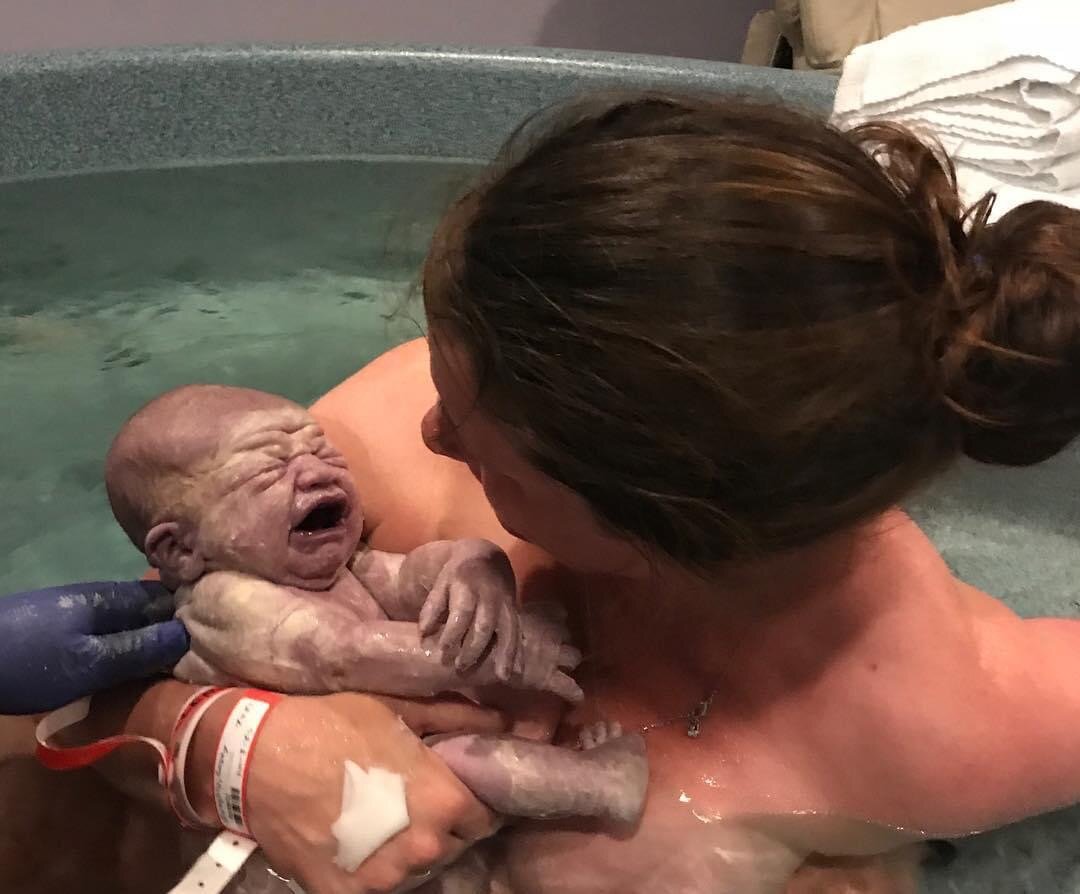Repeat clients, Ashley and Stephen, welcomed their second baby in the most beautiful healing, family-centered cesarean, the likes of which are sadly still hard to come by in our area. Ashley’s first baby was in the breech position late in pregnancy, and given her provider’s protocols, welcomed that baby in a scheduled c-section. It wasn’t bad, as c-sections go, except it left her feeling like she missed out on something. And the separation from her baby initially did not help her to feel bonded and like she birthed her child. So, when she saw the positive pregnancy test, she was on a mission to do all she could to have a very different birth experience. This began with securing her best chance for a VBAC. Her unicornuate uterus was a potential challenge, as it would make her second baby more likely to settle in the breech position. But she was not swayed from her goal and did her part with optimal fetal positioning.
But her baby was confirmed breech late in the pregnancy and since she had the previous uterine scar, her providers were not comfortable doing an external cephalic version (rotating baby to head down by manipulating the mom’s belly). Ashley was extremely disappointed and at a loss for options. She studied Spinning Babies and even invested in an inversion table, but to no avail. Her son was still breech. So before completely consigning herself to a repeat c-section, Ashley sought a second opinion. Enter West End Midwifery. This second opinion would turn out to be the single more important thing she did to impact her birth. In one visit just a few weeks from her due date, Ashley felt listened to and the skilled obgyn was able to successfully rotate her baby to the head down position in an ECV. She and her husband drove the 90-minutes home with a renewed fervor and desire for the VBAC they had originally hoped for. Ashley planned to stay with her original providers but as her blood pressure trended higher that week, there was strong talk of admission to the hospital and induction. So, Ashley officially switched care to West End Midwifery in Richmond, making the weekly drive and keeping close tabs on her blood pressure at home. The trust her new providers had in her was illuminating and really helped her to feel supported to follow her intuition regarding the birth.
Then Ashley was thrown another curve ball. Her water broke. I got the text at 8:30 that morning. She called her new providers who recommended she make her way up to Richmond to be seen in the office. Her water was confirmed broken so the doctor recommended she drink a castor oil shake, get something to eat, and walk around. It didn’t take long for Ashley’s uterus to start contracting and by late that afternoon, Ashley’s contractions were steady at 5 minutes apart. She could still talk through them so they would keep me posted. A couple of hours later, hooked to the monitor and admitted to the hospital, it was time to join them. Ashley’s contractions were relentless at 5 minutes apart and stopping her in her tracks—no walking or talking. I arrived by 9:00 that night.
I was immediately amazed and impressed by what I saw. There were twinkle lights strung from the ceiling and a diffuser with essential oils filling the room with lavender. The diffuser was plainly marked as hospital property, which was an amazing addition. In the corner were various birth balls, a peanut ball, and even a cub inflatable birthing chair. The room was abundantly equipped for labor, and aside from the hospital bed, might have been mistaken for a birth center. The shower and tub were one, and included jets and two shower heads, one removable for more focused hydrotherapy. Perhaps most intriguing was the trio of lights that could glow in virtually any color imaginable. Ashley could truly make that space her own and could envision welcoming her baby in that space. It goes without saying that they had multiple wireless options for monitoring—the telemetry unit, but also the Monika which is a sticker monitor that allows excellent contact with baby and laboring freedom for mom.
Ashley had some scar tissue from a previous LEEP that her doctor tried to break up. She was laboring hard but her cervix was not opening. She was left to labor freely as she wished, while her nurse checked on her blood pressure regularly. It did creep up but following hospital protocols, Ashley was given some oral medication before any talk of magnesium. Thankfully, it lowered her blood pressure and secured her freedom to continue laboring without an epidural.
Ashley spent most of the night doing every possible thing. She labored on her hands and knees, sitting on the birth ball and birthing chair, walking the hallways, all while waves of nausea came and went. Peppermint essential oil was a permanent fixture whether in the diffuser or close by on a cotton ball, a much more pleasant and effective tool for battling nausea. She took a walk on the unit as well but returned to her room shortly thereafter. She was do drawn into her labor to be out and about. This was a good sign of progress, it seemed. I did the Three Sisters of Balance to bring Ashley’s pelvis into balance and she had an emotional release in the process, a very healthy thing for her to do! I hoped in the letting go of her tears she might also be able to let go within to birth her baby.
And as expected, Ashley was growing weary. So, we positioned the bed into a throne to allow her to lean back against a pillow between contractions, and labor upright and forward without having to fully support her weight on her knees and legs. The doctor came in to do an exam and despite 10 hours of regular contractions, Ashley was still not dilated. He suspected the scar tissue was the culprit but to break it up he would need to be more invasive than previous attempts. To preserve her energy, provide complete pelvic relaxation, and to help maintain a lower blood pressure, Ashley opted for an epidural. She felt safe and supported in her choice, knowing her doctor was trying valiantly to give her every chance at a VBAC. This was one in many steps toward that end. Once comfortable, the obgyn broke up the scar tissue and inserted a foley catheter to hold the cervix open until it dilated on its own. Pitocin was also added to the mix at 6:30 to bring stronger contractions than before. They had also spaced out as Ashley rested, so it would bring them closer. Her water had been broken for 22 hours at this point.
Shift change at 7:00 am brought a new nurse and a new doctor and midwife. Before the original obgyn left, he removed the foley and was pleased to confirm that Ashley was dilated 6 cm. His strategy seemed to be working. With pitocin at 8.0 mu, we were hopeful for an active labor pattern and continued cervical change soon. Ashley breathed more deeply into each contraction, a clue to us that they were intensifying. She continued her laboring most of the day, just as she had overnight. We changed her position in the bed from side-lying with a peanut ball, to side-lying with a stirrup, and even to hands and knees. But by that afternoon, even after position changes and steady pitocin and consistent contractions, Ashley was dilated to 4 cm. But more significant than that was the fact that her baby had not moved down at all. This was very telling and it was time to have a frank conversation.
The midwife recommended a c-section but one very different than her previous. She would have both the obgyn and the midwife participate in the birth. And here is how it went. The obgyn did the surgical part of the birth and their baby was birthed into the midwife’s hands and passed directly to Ashley. There was no stop at the warmer. Instead, he went straight to his mother for instant skin-to-skin. He cleared her fluids well with crying and some bulb suction, and Stephen cut his son’s cord as he rested on Ashley. They were never separated at any point during the c-section. Benton Leopold was born at 4:18 pm on March 31, 2021 in a very healing birth.
Ashley was returned to her labor and delivery room for her recovery period and Benton latched well for her, especially after his uninterrupted skin-to-skin time. He weighed 6 lb. 6 oz. and spent his first hour of life in his mom’s arms. Ashley emerged from the birth with the most peaceful smile on her face. She was thrilled to have a healthy baby but just as excited to feel the healing that comes from feeling heard. Ashley was met at every turn in Richmond with open minds and hearts. And when her baby was born 32 hours after her water broke, there was not an alarmist response. Instead, she was met with patience, reasonable diligence, and open communication. Ashley was beaming! In welcoming her son, she also welcomed her own motherhood, a stronger, more self-assured mother. She found her voice and listened to it this time, doing the hard things like driving far, and using every possible comfort measure and position to make it happen. She can do hard things. And in doing the hard things, she found herself. And I couldn’t be happier for her or more honored to have watched it happen. Welcome to the world, Benton Leopold!

